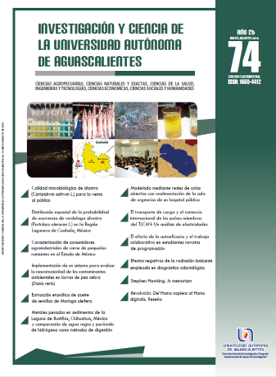Distribución espacial de la probabilidad de ocurrencia de verdolaga silvestre (Portulaca oleracea L.) en la Región Lagunera de Coahuila, México
DOI:
https://doi.org/10.33064/iycuaa2018741716Palabras clave:
distribución espacial, interpolación Kriging, Portulaca oleracea, regresión logística, clases de tierrasResumen
El interés por introducir verdolaga (Portulaca oleracea L.) como planta cultivable se ha incrementado paulatinamente debido a sus propiedades medicinales. Sin embargo, estudios acerca de su distribución espacial y relación con el tipo de suelo son escasos. Los objetivos del presente trabajo fueron determinar la probabilidad de ocurrencia de verdolaga, así como la relación entre su distribución espacial y las características edáficas en la Región Lagunera. Se obtuvieron datos de presencia/ausencia de esta planta y muestras de suelo superficial de sitios en distintas clases de tierra, y se determinaron las características físicas y químicas de los suelos. Los datos obtenidos se utilizaron para estimar la probabilidad de ocurrencia de verdolaga con una regresión logística y se cartografiaron. Los resultados muestran que la arena, la conductividad eléctrica y el pH influyen en la presencia de la verdolaga y su distribución espacial es diferente.
Descargas
Citas
• Alam, M. A., Juraimi, A. S., Rafi, M. Y., Hamid, A. A., Aslani, F. & Alam, M. Z. (2015). Effects of salinity and salinity-induced augmented bioactive compounds in purslane (Portulaca oleracea L.) for possible economical use. Food Chemistry, 169, 439-447.
• Barrera-Bassols, N., Zinck, J. A., & Van Ranst, E. (2006). Local soil classification and comparison of indigenous and technical soil maps in Mesoamerican community using spatial analysis. Geoderma, 135, 140-162.
• Blázquez, M. A., & Carbó, E. (2015). Control of Portulaca oleracea by boldo and lemon essential oils in different soils. Industrial Crops and Products, 76, 515-521.
• Brady, N. C., & Weil, R. R. (2008). The nature and properties of soils. (14th. ed.). Upper Saddle River, NJ, US: Pearson-Prentice Hall.
• Cruz-Cárdenas, G., Ortiz-Solorio, C. A., Ojeda-Trejo, E., Martínez-Montoya, J. F., Sotelo-Ruiz, E. D., & Licona-Vargas, A. L. (2010). Evaluation of four digital classifiers for automated cartography of local soil classes based on reflectance and elevation in Mexico. International Journal of Remote Sensing, 31(3), 665-679.
• García, E. (2004). Modificaciones al sistema de clasificación climática de Köppen. D. F., México: Universidad Nacional Autónoma de México.
• IUSS Working Group WRB. (2015). World Reference Base for Soil Resources 2014: International soil classification system for naming soils and creating legends for soil maps. World Soil Resources Reports No. 106. Rome, Italy: FAO.
• Kafi, M., & Rahimi, Z. (2011). Effect of salinity and silicon on root characteristics, growth, water status, proline content and ion accumulation of purslane (Portulaca oleracea L.). Soil Science and Plant Nutrition, 57(2), 341-347.
• Licona-Vargas, A. L., Ortiz-Solorio, C. A., Gutiérrez-Castorena, M. C., & Manzo-Ramos, F. (2006). Clasificación local de tierras y tecnología del policultivo café-plátano para velillo-sombra en comunidades cafetaleras. Terra Latinoamericana, 24(1), 1-7.
• Liu, L., Howe, P., Zhou, Y. F., Xu, Z. Q., Hocart, C., & Zhan, R. (2000). Fatty acids and beta-carotene in australian purslane (Portulaca oleracea) varieties. Journal of Chromatography A, 893(1), 207-213.
• Mera-Ovando, L. M., Bye-Boettler, A., & Solano, M. L. (2014). La verdolaga (Portulaca oleracea L.). Fuente natural de Omega 3 y Omega 6. Agroproductividad, 7(1), 3-7.
• Ortiz-Solorio, C. A., & Gutiérrez-Castorena, M. C. (1999). Evaluación taxonómica de sistemas locales de clasificación de tierras. Terra Latinoamericana, 17(4), 277-286.
• __________ (2001). La etnoedafología en México, una visión retrospectiva. Etnobiología, 1(1), 44-62.
• Ortiz-Solorio, C. A., Gutiérrez-Castorena, M. C., Licona-Vargas, A. L., & Sánchez-Guzmán, P. (2005). Contemporary influence of indigenous soil (Land) classification in Mexico. Eurasian Soil Science, 38, S89-S94.
• Palaniswamy, U. R., Bible, B. B., & McAvoy, R. J. (2002). Effect of Nitrate: Ammonium Nitrogen Ratio on Oxalate Levels of Purslane. En J. Janick & A. Whipkey (Eds.), Trends in new crops and new uses (pp. 453-455). Alexandria, VA: ASHS Press.
• Ren, S., Weeda, S., Akande, O., Guo, Y., Rutto, L., & Mebrahtu, T. (2011). Drought tolerance and AFLP-based genetic diversity in purslane (Portulaca oleracea L.). Journal of Biotech Research, 3(1), 51-61.
• Rinaldi, R., Amodio, M. L., & Colelli, G. (2010). Effect of temperature and exogenous ethylene on the physiological and quality traits of purslane (Portulaca oleracea L.) leaves during storage. Postharvest Biology and Technology, 58(2), 147-156.
• Schabenberger, O., & Pierce, F. J. (2002). Contemporary statistical models for the plants and soil science. Boca Raton, FL: CRC Press LLC.
• Segura-Castruita, M. A., Huerta-García, A., Fortis-Hernández, M., Montemayor-Trejo, J. A., Martínez-Corral, L., & Yescas-Coronado, P. (2014). Cartografía de la probabilidad de ocurrencia de Atriplex canescens en una región árida de México. Agrociencia. 48(6): 639-652.
• Segura-Castruita, M. A., Martínez-Corral, L., García-Barrientos, E., Huerta-García, A., García-Hernández, J. L., Fortis-Hernández, M.,… Preciado-Rangel, P. (2012). Localization of local soil classes in an arid region of Mexico, using satellite imagery. International Journal of Remote Sensing, 33(1), 184-197.
• Teixeira, M., & Carvalho, I. S. (2009). Effects of salt stress on purslane
(Portulaca oleracea) nutrition. Annals of Applied Biology, 154(1), 77-86.
• Van Horssen, P. W., Pebesma, E. J., & Schot, P. P. (2002). Uncertainties
in spatially aggregated predictions from a logistic regression model. Ecological Modelling, 154(1-2), 93-101.
• Van Reeuwijk, L. P. (2006). Procedures for soil analysis (7th. ed.). Tech. Pap. 9. Wageningen, Netherlands: ISRIC-World Soil Information.
• Yazici, I., Türkan, I., Sekmen, A. H., & Demiral, T. (2007). Salinity tolerance of purslane (Portulaca oleracea L.) is achieved by enhanced antioxidative system, lower levels lipid peroxidation and proline accumulation. Environmental and Experimental Botany, 61(1), 49-57.
Descargas
Publicado
Cómo citar
Licencia
Las obras publicadas en versión electrónica de la revista están bajo la licencia Creative Commons Atribución-NoComercial-CompartirIgual 4.0 Internacional (CC BY-NC-SA 4.0)









